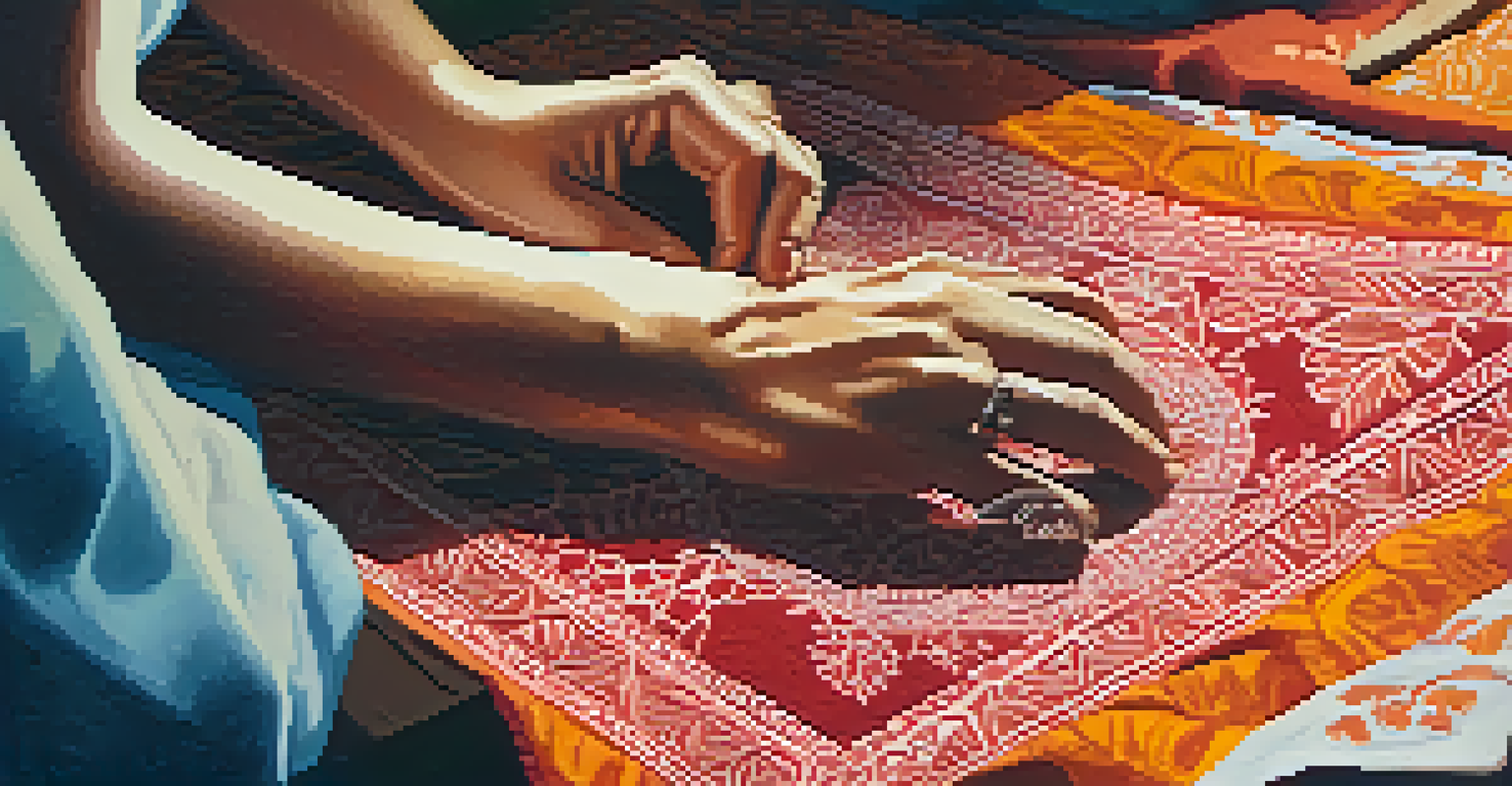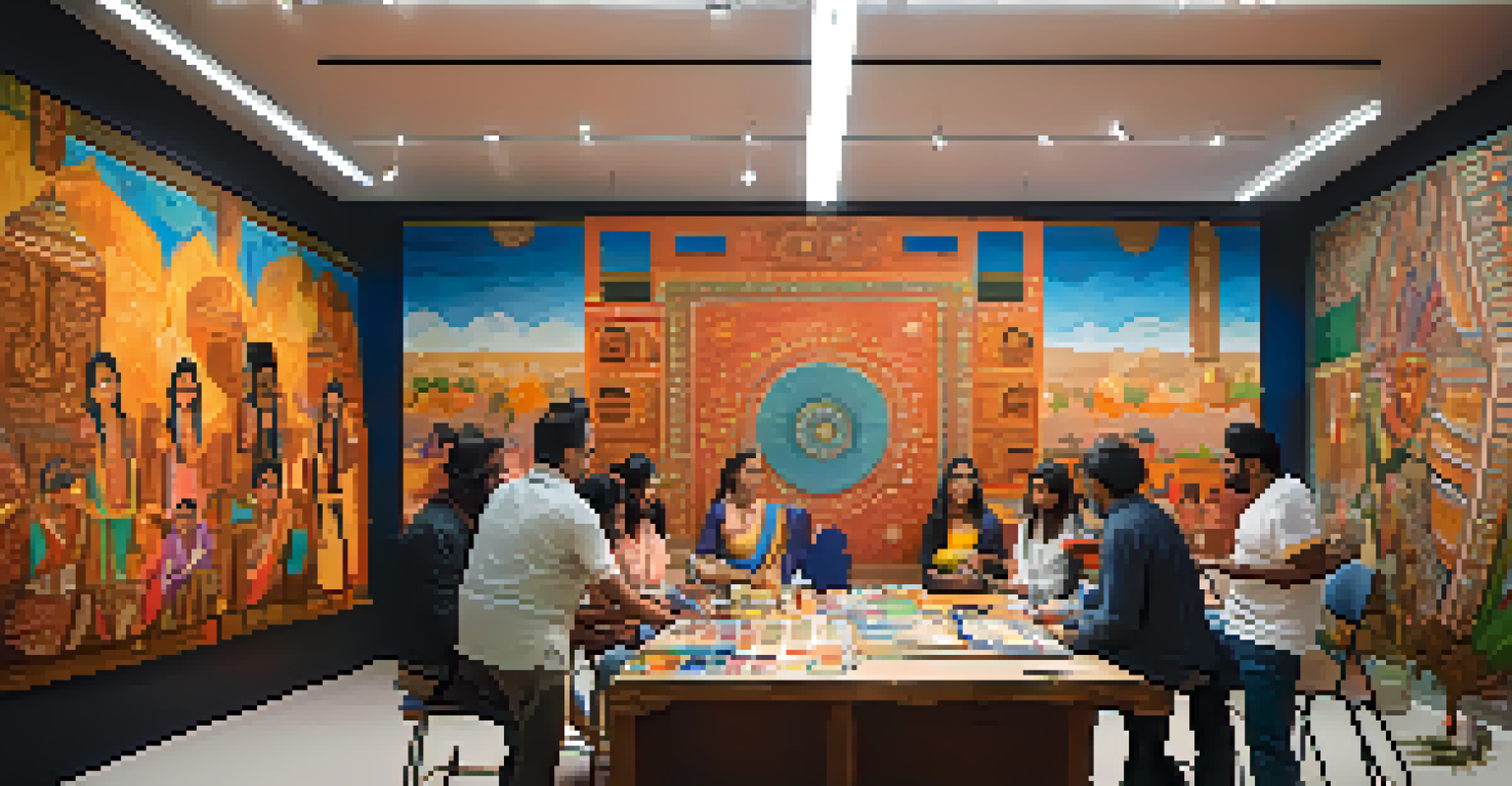The Importance of Cultural Heritage in Indian Art Workshops

Understanding Cultural Heritage in Indian Art
Cultural heritage in Indian art refers to the rich traditions, practices, and values that have been passed down through generations. It encompasses various forms of artistic expression, including painting, sculpture, dance, and music. By understanding this heritage, artists can draw inspiration from the past, weaving it into their contemporary creations.
Art is a language that speaks to the soul, a form of expression that transcends boundaries and cultures.
Art workshops that focus on cultural heritage allow participants to connect with their roots, fostering a deeper appreciation for their history. This connection not only enriches the artistic process but also enhances the emotional resonance of the art produced. As artists engage with traditional techniques and themes, they bring a unique perspective to modern art.
Moreover, recognizing the significance of cultural heritage helps preserve these traditions for future generations. By teaching the younger demographic about their artistic roots, workshop facilitators ensure that these cultural narratives continue to thrive and evolve in a modern context.
The Role of Storytelling in Art Workshops
Storytelling is a powerful tool in Indian art, often serving as a vehicle for conveying cultural values and historical narratives. In art workshops, storytelling can inspire participants to create works that reflect their personal experiences or community stories. This connection to storytelling allows for a richer artistic journey, making the creative process more meaningful.

When workshop participants learn about the stories behind traditional art forms, they gain insight into the cultural significance of their work. For instance, understanding the mythological tales depicted in Madhubani paintings can inspire artists to incorporate these elements into their own pieces. This blending of traditional stories with personal narratives creates a dynamic artistic expression.
Cultural Heritage Enriches Art
Understanding and integrating cultural heritage in art workshops enhances creativity and emotional depth in artistic expression.
Additionally, storytelling fosters collaboration among participants, encouraging them to share their unique perspectives. This collaborative spirit enriches the workshop environment, leading to a diverse range of artistic outputs that reflect a multitude of cultural backgrounds.
Promoting Creativity Through Cultural Practices
Cultural practices play an essential role in nurturing creativity during art workshops. Engaging with traditional techniques—like block printing or pottery—offers participants a chance to explore their creativity within structured frameworks. This blend of tradition and innovation allows for a unique artistic exploration, sparking fresh ideas and perspectives.
Cultural heritage is the glue that binds us together, a legacy that connects generations through the stories we share.
For example, when artists experiment with traditional patterns and modern styles, they can create entirely new forms of expression. This process not only honors the past but also encourages evolution within the art community. Workshops designed around these practices can lead to groundbreaking works that reflect both heritage and contemporary influences.
Furthermore, promoting these cultural practices helps participants develop a sense of identity and belonging. As they create art that resonates with their heritage, individuals foster a deeper connection to their culture and history, which can be incredibly empowering.
Building Community Through Shared Heritage
Art workshops centered around cultural heritage can foster a strong sense of community among participants. When individuals engage with shared traditions, they form connections that transcend personal backgrounds. This communal experience can lead to lasting relationships and collaborative projects that celebrate their collective identity.
Moreover, these workshops provide a platform for intercultural dialogue. Participants from different backgrounds can share their unique interpretations of art, leading to a richer understanding of one another's cultural heritage. This exchange not only enhances the artistic experience but also promotes inclusivity and respect for diversity.
Storytelling Drives Artistic Creation
Incorporating storytelling into art workshops allows participants to connect personal narratives with traditional themes, fostering richer artistic experiences.
As communities come together to explore their cultural roots through art, they create a supportive environment that encourages growth and collaboration. This sense of belonging can be profoundly transformative, empowering individuals to express their unique voices while honoring their shared heritage.
Encouraging Preservation of Traditional Arts
One of the significant benefits of art workshops focused on cultural heritage is the promotion of traditional art forms. By engaging participants in these practices, facilitators help preserve techniques that might otherwise fade into obscurity. This preservation is essential for maintaining the diversity of India's artistic landscape.
Participants in these workshops often learn the historical context and significance of traditional art forms, which instills a sense of responsibility to carry these practices forward. For instance, learning about the intricate details of Warli painting can inspire a new generation to continue this unique art form. This connection encourages participants to become ambassadors for their cultural heritage.
Furthermore, as traditional arts are showcased in contemporary settings, they gain new relevance and appreciation. Workshops can serve as a springboard for artists to innovate while respecting time-honored methods, ensuring that these traditions remain vibrant and relevant in today's art scene.
Fostering Innovation Through Cultural Exploration
While cultural heritage provides a foundation for artistic expression, it also serves as a springboard for innovation. In art workshops, participants are encouraged to experiment with traditional styles and adapt them to modern contexts. This fusion of old and new can lead to exciting artistic breakthroughs.
For instance, an artist might take the vibrant colors of traditional Indian textiles and reinterpret them through digital media. This kind of innovative thinking not only breathes new life into established art forms but also attracts a wider audience to appreciate these works. It shows that cultural heritage is not static; it can evolve and inspire new generations.
Community Strengthens Through Art
Art workshops centered on cultural heritage create a sense of belonging and promote collaboration among diverse participants.
Moreover, fostering innovation within the framework of cultural heritage helps artists address contemporary issues. By embedding modern themes within traditional contexts, creators can comment on societal challenges while honoring their roots, making their work even more impactful.
The Global Impact of Indian Cultural Heritage
Indian cultural heritage has a far-reaching influence that extends beyond its borders. As art workshops introduce participants to traditional practices, they also promote cultural exchange on a global scale. This exchange enriches the global art community, allowing for a deeper understanding of diverse artistic expressions.
Through collaborations and exhibitions that showcase the results of these workshops, Indian art can reach international audiences. This exposure not only elevates the profile of Indian artists but also highlights the importance of protecting and promoting cultural heritage worldwide. It’s an opportunity to share the richness of Indian traditions with the world.

Furthermore, as artists from various backgrounds engage with Indian cultural practices, they contribute to a more inclusive understanding of art. This global dialogue fosters greater appreciation for diversity, encouraging artists to embrace and celebrate their unique cultural narratives while learning from one another.